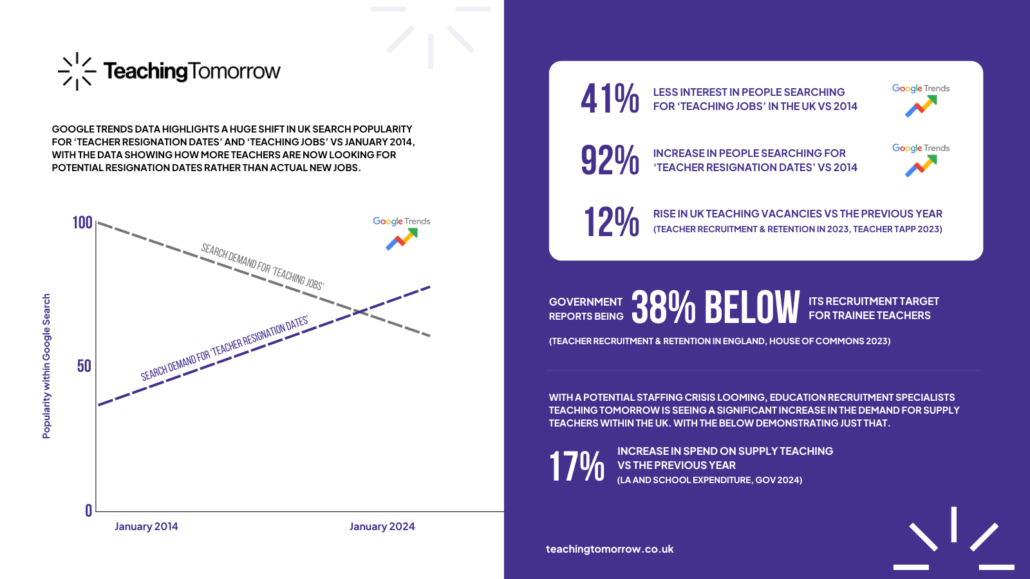UK Schools Face Looming Staffing Crisis

Perfect storm of resignations, missed recruitment targets and lack of SEND provisions means more schools are turning to supply staff to plug the gaps
Google searches for ‘teacher resignation dates’ in the UK have more than doubled in the last 10 years. Combine this with a 32% decrease in Google searches for ‘teaching jobs’ and it’s clear to see that schools are faced with multiple teaching vacancies with no new recruits to fill them. Increasingly, schools are turning to supply teachers to plug these gaps, with supply agency Teaching Tomorrow noticing a marked increase in the demand for supply teachers over the last 12 months. UK Government statistics also show that schools spent £485.6 million on agency supply teaching staff in 2022-23, a 17% increase on the previous 12 months.
The start of the new school term sees headteachers trying to assess their recruitment and staffing needs for September 2025, as well as facing the challenge of submitting budgets ahead of the next academic year without knowing exactly what staffing vacancies they will have. Due to the stringent deadlines around when teachers have to submit their resignations, teaching staff can wait until May to submit a resignation for the current academic year. By then, most teaching staff, including early career teachers (ECTs), will have secured contracts for September, meaning many schools then struggle to recruit in time for September and the start of a new academic year.
As well, schools are seeing increasing numbers of children with special educational needs (SEN), many requiring specialist staff and dedicated provisions to enable them to thrive within an educational setting. Local authorities are not keeping pace with demand, as recently evidenced by the damning CQC and Ofsted report about the SEND provision in North Northants, which means individual schools need to find their own solutions, having to fund and employ specialist staff while waiting for diagnoses, EHCP funding or spaces at specialist provisions to arise.
Additional research highlights a significant rise in teacher vacancies, with secondary schools harder hit than primaries. Also, the Government has repeatedly missed targets for recruiting trainee teachers, with postgraduate teacher recruitment in 2023/2024 sitting at 38% below target.
A headteacher said: “We simply can’t recruit at the moment. We’re seeing more resignations than in the past and there just aren’t enough teachers and teaching assistants on the jobs market to fill the gaps that these resignations are creating. Add to this the fact that we’re expected to budget in April for September even though we still might see more resignations in May, and it’s not hard to see why we’re struggling in the face of this looming staffing crisis.”
A school HR manager said: “Recruitment has definitely become more challenging after COVID-19 and we’ve noticed a decrease in the number of applicants applying for teaching positions, especially applicants from the UK, which has led to an increase in applications from overseas candidates and they require sponsorship. There’s also a distinct shortage of newly qualified staff, meaning there’s more competition between schools to secure these new teachers.”
With a view to finding a solution to the recruitment challenge, more schools are turning to supply teachers to plug the gaps. At the same time, more teachers are choosing the supply route over full-time, permanent contracts, preferring the flexibility and decreased workload that supply contracts can represent.

Adam Shulman, co-founder of supply agency, Teaching Tomorrow said: “We’re definitely facing more calls for supply staff right across the UK than in the past. Whereas traditionally supply staff were used to cover sickness and other shorter absences, we’re now seeing an increased demand for longer-term supply contracts. Not only does this help to provide that all-important consistency for children but it also means that schools don’t have to rely on ‘making do’ by shuffling existing teachers and teaching assistants around to fill these staffing gaps.”

